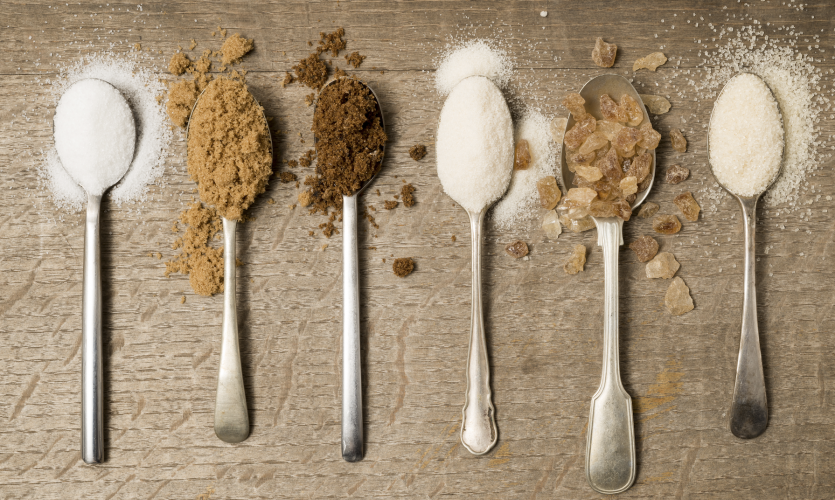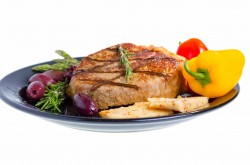The AHA estimates that the average American consumes more than 60 pounds of added sugar every year.
*Studies show the link between excess sugar intake and weight gain, even among people who exercise. Why? Sugar contains empty calories and too many calories in and not enough calories burned leads to weight gain. But there’s a less obvious reason: too much sugar can interrupt our body’s natural processes. In particular, sugar may interfere with leptin, a hormone the body produces to regulate hunger and weight gain. *Studies show that sugar may lead to leptin resistance — which can trigger obesity.
Learn more about how sugar causes weight gain in the short video: What Does Sugar Really Do In Your Body?
Added sugar is everywhere. It’s where you expect it – soft drinks, ice cream, cakes, and cookies — and places where you might not — sports drinks, instant oatmeal, barbecue sauce, and yogurt. The American Heart Association recommends 24 grams for women and 36 grams for men per day. For perspective, the average can of soda has 65 grams in it.
Processed Foods with High Amounts of Added Sugars
Condiments/Sauces/Dressings
Cocktail sauce – 35g/2 oz
Salad dressing – balsamic vinaigrette – 56g/tbsp
Salad dressing – light ranch – 35g/2 tbsp
Ketchup – 4g/tbsp
Barbecue sauce – 6g/tbsp
Teriyaki sauce – 3g/tbsp
Marinara sauce – 4g/4 oz
Grains
Oatmeal – instant flavored – 12g/packet
Bran muffins – store bought – 10g/muffin
Cereal bars – 30g/bar
Cereal – corn flakes – 5g/8 oz
Granola – 5.2 g/2 oz
Whole wheat bread – 6g/1 oz slice
Beverages
Flavored frappucino coffee – bottled – 332g/9.5 oz
Grapefruit juice – bottled – 28g/8 oz
Energy drinks – 15 – 25g/8 oz
Vitamin water – 24g/bottle
Bottled peach mango smoothies – 18g/8 oz
Almond milk – vanilla, sweetened – 17g/8 oz
Cold-pressed juice – 13g/12 oz
Dairy
Blueberry – fruit-flavored yogurt – 18 – 27g/6 oz
Low-fat vanilla yogurt – 3g/2 oz
Fruits
Canned peaches – light syrup – 4g/4 oz
Applesauce – 15g/4 oz
Grapefruit sections with juice – 4g/8 oz
MISC
Popcorn – microwave – 16g/8 oz
Tomato soup, canned and condensed – 12g /8 oz
Frozen cheese pizza – personal – 7g/1 pizza
What to do about all this sugar
- Eat whole foods. This is easy when you follow your TLS menu plan and recipe booklets. Yes, we know, that some whole foods like fruit may contain sugar, but it’s natural and has not been added by a manufacturer.
- Make your own salad dressings and sauces. Even if you feel like your homemade pizza sauce needs a little sweetening with honey, maple syrup, or monk fruit, you’ll control the sugar content.
- Read labels and compare. But know what you’re looking for. Added sugar can hide under lots of different names — see below.
- Drink water, tea, and coffee. Just don’t add anything to it. A splash of some popular coffee creamers can have more than 5 grams of added sugar per serving. Fruit juices and sugary sodas contain a ton of added sugar — avoid them.
- Use low-sugar recipes. Cooking your own food helps you manage your intake — focus on healthy recipes that use less sugar than traditional meals.
Sugar masquerades under many different names, some of which you’re probably familiar with and others you may not be.
Dextrose
Maltose
Glucose
Sucrose
Fructose
High Fructose Corn Syrup
Honey
Fruit Juice
Evaporated Cane Juice
Dextrin
Maltodextrin
Refiner’s Syrup
Sweet Sorghum
Molasses
Corn Sweetener
Beet Sugar
Barley Malt
Corn Syrup
Which hidden sugar are most surprised about? Let us know what steps you’re taking to limit your sugar intake.
Melanie Nelson
Director of TLS Sales
These statements have not been evaluated by the Food and Drug Administration. These products are not intended to diagnose, treat, cure, or prevent any disease.





Comments (0)